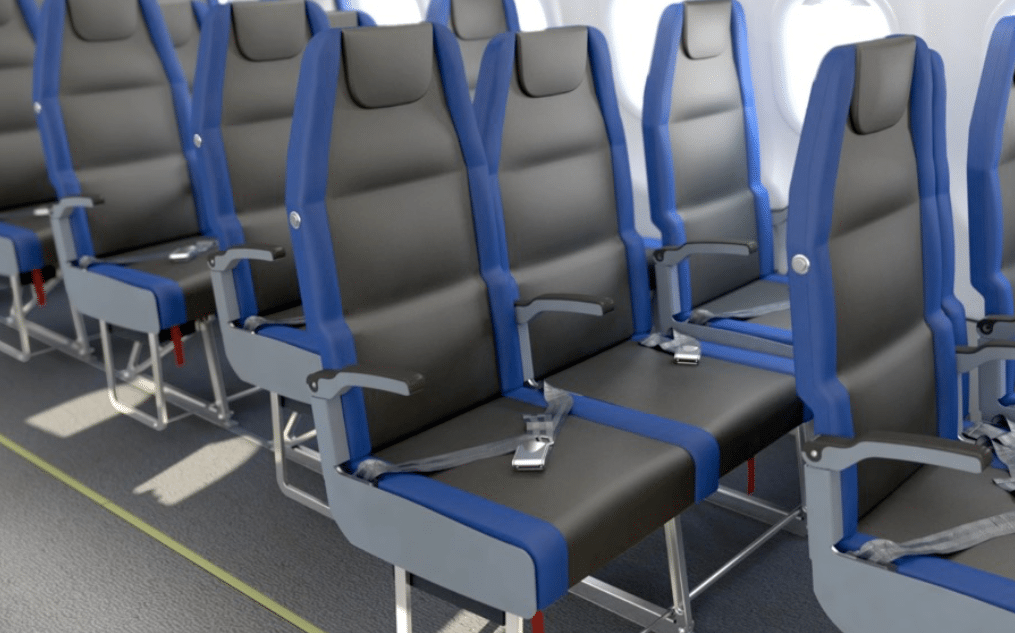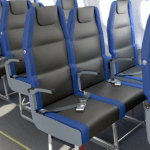Skift Take
Time and London will tell. We’ll be there. If there are any big orders, we’ll be sure to report on them.
- Rendering of Side-Slip seat.
- Rendering of Side-Slip seat.
- Rendering of Side-Slip seat.
The slip-sliding, aisle-widening Side-Slip seat is back, and one step closer to launch.
Denver-based Molon Labe Designs LLC, developers of the Side-Slip Seat, which would ease aircraft boarding, took some time to go back to the drawing board after the product’s debut at the Aircraft Interiors Expo in Hamburg in 2013. But the independent seat manufacturer has now released a big update on the seat’s progress, and hopes to entice budget airlines around the world to buy at the upcoming World Low-Cost Airlines Conference in London.
For those unfamiliar with the seat, it is a slim-line economy aircraft seat expressly designed for the short-haul, low-cost airline market. Because it is stackable and staggered, the aisle seat can slide over the middle seat during the boarding process, creating a 41” aisle.
This allows a better flow of passengers during boarding and deplaning (when compared to a standard 19” aisle) and would also make it easier for disabled passengers to board the aircraft with a standard wheelchair.
The staggering of the seat has the added benefit of giving all passengers seated extra room at the shoulders. The aisle and window seats are a respectable 18-inches wide, the middle seat is a very comfy 20-inches.
https://youtu.be/oX9kCgrJBbQ
The seat’s developer, and Molon Labe CEO, Hank Scott, argues that the Side-Slip benefits passengers and airlines equally. Reducing the turn-around time between flights by 10-15 minutes, might improve on-time performance and allow airlines to better utilize their aircraft, he says.
In a simulated boarding study, Molon Labe determined that the Side-Slip seat can reduce boarding time by 4-7 minutes compared to standard fixed seats on the Airbus A320, depending on the boarding process of the airline.
https://youtu.be/4twUOhpJfTA
Scott also argues that the seat is environmentally friendly, with “less fuel wasted powering up essential services like air-conditioning and lighting” because the aircraft can be returned to service in a shorter interval.
The seat is also made from sustainable materials, with an option for recyclable seat cushions and Eco-friendly, durable, compressed leather (E-Leather®) covers.
A Challenge to Get Onboard
For any independent, entering the fray in aircraft seating requires a staggering amount of determination. The seat certification process is arduous for minor changes to existing seats; more so when developing a new seat concept. But Molon Labe Designs has been busy with due diligence.
“We are half way through FAA certification testing with our partners at NIAR (National Institute for Aviation Research, Wichita State University)—the world leaders in seat certification testing,” says Scott. “We are also half way through our reliability testing—which is going great—this seat is tough.”
It is also a tough sell. Airlines are notoriously conservative when making their aircraft seating choices, and tend towards proven products already in service. The aircraft manufacturers’ catalogue approach, which favors pre-certified, base model seating, also encourages this behavior.
It’s not impossible for a new manufacturer to enter the seating game. Others have succeeded, but generally with seats that are like-to-like in form, fit, and function when compared to existing seats in the market. Even manufacturers who already sell seats to airlines have trouble selling their more blue sky designs, regardless of potential benefits to passengers and to the airline.
But Scott is optimistic. “We have the seats built, we have been testing them with the general public and they absolutely love them,” he says. “We know that a wider aisle during boarding and disembarking is nice but what surprised us is the overwhelming love for the increase shoulder, arm, elbow, hip and thigh space that all passengers have because of our staggered design. It seems that we have figured out how to increase airline profits while also improving the customer experience.”
The seat has previously been applauded by those who seek better aircraft solutions for disabled and reduced mobility passengers. With the aging population, it is this passenger demographic who could push this type of passenger-friendly seating past that ‘unfamiliar concept’ hurdle.
The Daily Newsletter
Our daily coverage of the global travel industry. Written by editors and analysts from across Skift’s brands.
Have a confidential tip for Skift? Get in touch
Tags: aircraft interiors
Photo credit: Rendering of Side-Slip seat. Molon Labe Designs, LLC



